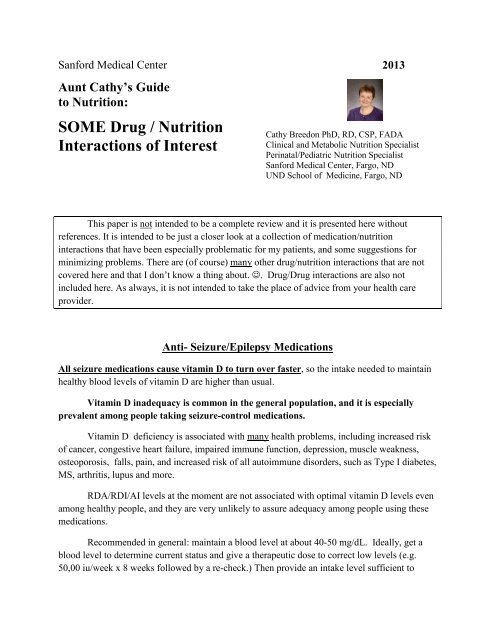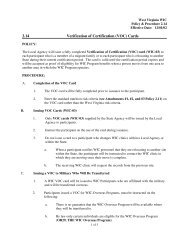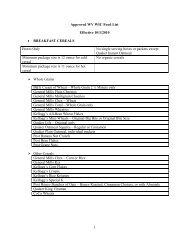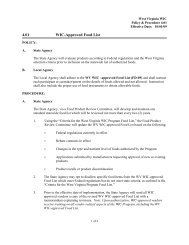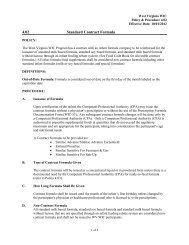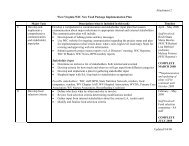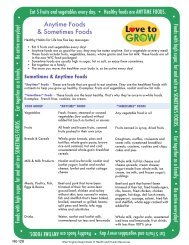SOME Drug / Nutrition Interactions of Interest
SOME Drug / Nutrition Interactions of Interest
SOME Drug / Nutrition Interactions of Interest
Create successful ePaper yourself
Turn your PDF publications into a flip-book with our unique Google optimized e-Paper software.
Sanford Medical CenterAunt Cathy’s Guideto <strong>Nutrition</strong>:<strong>SOME</strong> <strong>Drug</strong> / <strong>Nutrition</strong><strong>Interactions</strong> <strong>of</strong> <strong>Interest</strong>2013Cathy Breedon PhD, RD, CSP, FADAClinical and Metabolic <strong>Nutrition</strong> SpecialistPerinatal/Pediatric <strong>Nutrition</strong> SpecialistSanford Medical Center, Fargo, NDUND School <strong>of</strong> Medicine, Fargo, NDThis paper is not intended to be a complete review and it is presented here withoutreferences. It is intended to be just a closer look at a collection <strong>of</strong> medication/nutritioninteractions that have been especially problematic for my patients, and some suggestions forminimizing problems. There are (<strong>of</strong> course) many other drug/nutrition interactions that are notcovered here and that I don’t know a thing about. . <strong>Drug</strong>/<strong>Drug</strong> interactions are also notincluded here. As always, it is not intended to take the place <strong>of</strong> advice from your health careprovider.Anti- Seizure/Epilepsy MedicationsAll seizure medications cause vitamin D to turn over faster, so the intake needed to maintainhealthy blood levels <strong>of</strong> vitamin D are higher than usual.Vitamin D inadequacy is common in the general population, and it is especiallyprevalent among people taking seizure-control medications.Vitamin D deficiency is associated with many health problems, including increased risk<strong>of</strong> cancer, congestive heart failure, impaired immune function, depression, muscle weakness,osteoporosis, falls, pain, and increased risk <strong>of</strong> all autoimmune disorders, such as Type I diabetes,MS, arthritis, lupus and more.RDA/RDI/AI levels at the moment are not associated with optimal vitamin D levels evenamong healthy people, and they are very unlikely to assure adequacy among people using thesemedications.Recommended in general: maintain a blood level at about 40-50 mg/dL. Ideally, get ablood level to determine current status and give a therapeutic dose to correct low levels (e.g.50,00 iu/week x 8 weeks followed by a re-check.) Then provide an intake level sufficient to
maintain the 40-50 range (which may be found to require supplementation to provide 2000-5000iu/day.) Please see my “Top Five” paper for more on this topic.All seizure medications cause decreased absorption <strong>of</strong> biotin (vitamin B7).Biotin is involved in many metabolic pathways, including the TCA Cycle to make ATP(making usable energy from food), and gluconeogenesis (making glucose out <strong>of</strong> amino acids.)Deficiency in general seems to be uncommon in healthy people, but when it does occur it hasbeen known to result in a number <strong>of</strong> serious problems. It has been shown to contribute todepression, hallucinations, increased infections, poor muscle control, loss <strong>of</strong> hair, skin problems,seizures and developmental delay in infants. Eggs, nuts and legumes like peanuts are among thevery best dietary sources. Eggs do contain a protein called avidin that makes biotin be poorlyabsorbed if the egg is eaten raw, but cooked eggs are excellent sources <strong>of</strong> biotin … and also saferto eat in terms <strong>of</strong> food-borne illness risk. The yolk has most <strong>of</strong> the biotin.The intake <strong>of</strong> biotin assumed to meet the needs <strong>of</strong> most healthy people is about 30mcg/day. In addition to all seizure medications, alcohol also impairs absorption <strong>of</strong> biotin.Additionally, chronic antibiotic use decreases the biotin usually produced by bacterial activity inthe large intestine. People with intestinal absorption problems (such as inflammatory boweldisease) have also been observed to become deficient in biotin. It appears that biotinsupplementation can be useful for people with diabetes in particular.Because a very high biotin intake has no known detrimental effects, supplementation ator above levels recommended for healthy people is very reasonable for anyone on chronicseizure medications or in other situations described above. Not all multivitamins contain 30 mcgbiotin. However, it is easy to provide it singly if desired. For example, there are over-thecounterbiotin supplements that provide 600 mcg, and it can also be found in variable amounts asa part <strong>of</strong> “B-complex” vitamin supplements. The “B-100 Complex” type <strong>of</strong> supplement mayinclude 300 mcg <strong>of</strong> biotin along with many other B vitamins.Some Specific Seizure Medications That Interact with Nutrients.Phenytoin (Dilantin)Folic acid deficiency is associated with use <strong>of</strong> this medication if appropriatesupplementation is not provided. However, there are some safety issues to consider:When starting the prescription for phenytoin, it is recommended that people start folicacid supplementation right away. If a person is already on the drug and found to be folic aciddeficient, generous and rapid folic acid supplementation can cause problems. In the latter case,
the physician can introduce supplemental folic acid slowly to avoid breakthrough seizures, and towork up to achieving a normal blood folic acid level. This is important because it is clearly notsafe to simply let the person remain folic acid deficient. Folic acid deficiency is associated withbirth defects, poor DNA production, depression, high homocysteine level, increased risk <strong>of</strong>stroke and impaired immune function.The 1998 introduction <strong>of</strong> fortification <strong>of</strong> grain products with a well-absorbed form <strong>of</strong>folic acid in the US improves the odds <strong>of</strong> preventing some <strong>of</strong> the folic-acid related problems inthe US today. However, requirements continue to be higher than for people not using phenytoin.The usual intake suggested for most healthy people is 400 mcg folic acid /day, with 600 mcgrecommended in pregnancy. “Prenatal vitamins” <strong>of</strong>ten have 800 mcg <strong>of</strong> folic acid, but they<strong>of</strong>ten do not contain many other nutrients. For that reason, just recommending a prenatal vitaminis not a good solution to this problem. A better approach would be to provide as complete aregular multivitamin with minerals daily as possible, and add one or more tiny 400 mcg folicacid tablets.Other food sources include leafy greens and orange juice, but it is not clear that folates inthe form found naturally in foods are as well absorbed as supplemental forms among peopleusing this medication. And, as it is well known that there is significant genetic variation in one’sability to obtain folic acid from non-supplemented food sources, it is reasonable to be generous.Folic acid supplementation is simple, easy and safe at intake levels <strong>of</strong> 1000 mcg/day fromsupplements and fortified foods. That “upper limit” is based on the possibility that higheramounts might “mask” vitamin B12 deficiency, as recognized by elevated blood cell size. Itwas not due to any observed toxicity <strong>of</strong> the vitamin. However, large red blood cell size (MeanCell Volume on a laboratory test) is a very late appearing symptom <strong>of</strong> vitamin B12 deficiencyand it should not be relied upon to detect deficiency. Instead, steps described later should be ableto prevent vitamin B12 deficiency, so the “masking deficiency <strong>of</strong> vitamin B12” concern is nolonger an issue. There is also no evidence that naturally occurring folates in foods pose anythreat to health.In view <strong>of</strong> the well documented effect <strong>of</strong> phenytoin on folic acid status, it is reasonable tomonitor this, e.g. via erythrocyte folate levels, to determine the amount <strong>of</strong> supplementationneeded by an individual already on the drug. Before starting phenytoin, and in the absence <strong>of</strong> theability to monitor the situation with laboratory assessment, it is reasonable to just begin agenerous intake and maintain it … e.g. a regular intake <strong>of</strong> 1000 mcg supplement daily. Thisamount can be provided in a tiny pill by prescription … and that level <strong>of</strong> supplementation isavailable over-the-counter in Europe and elsewhere because <strong>of</strong> the excellent safety pr<strong>of</strong>ile. Onecould also achieve an intake level around that amount (1200) in the USA from, for example,taking a standard multivitamin plus two tiny 400 mcg folic acid tablets without prescription.
The use <strong>of</strong> this medication is associated with birth defects and a Fetal PhenytoinSyndrome has been described. Relative inadequacy <strong>of</strong> many B vitamins (including folic acid)induced by use <strong>of</strong> this medication appears to be contributory to the degree <strong>of</strong> damage. For thisreason, optimizing nutrition status in women <strong>of</strong> childbearing age is especially important. Butreally … it is mighty important for everyone. [Please see my “Folic Acid Absorption” cartoonpaper for further detail.]Vitamin B12 absorption is also impaired, so monitoring adequacy <strong>of</strong> vitamin B12 is important.As noted, normal Mean Cell Volume (red blood cell size) is NOT a useful assessment <strong>of</strong>adequacy … by the time the cells are large, a lot <strong>of</strong> other damage has already occurred, and notall <strong>of</strong> it is repairable. A serum B12 level would be a much better test. [To obtain the mostreliable and specific functional measure <strong>of</strong> vitamin B12 status, one could get a methylmalonicacid (MMA) level, which is more sensitive than a serum vitamin B12 level. However, this is notas available and it is more expensive.]Vitamin B12 is affected by other medications as well, and by age and by certaindietary practices. Please see more detail about vitamin B12 in the section below called “Gastroesophagealreflux (GERD) hyperacidity,” and see my “Vitamin B12” paper and “Vitamin B12Absorption” cartoon paper for further details.Thiamin (Vitamin B1) levels in the blood are depleted by the use <strong>of</strong> phenytoin.Rib<strong>of</strong>lavin (Vitamin B2) can also be depleted because the drug increases production <strong>of</strong> a liverenzyme that destroys it. Supplementation <strong>of</strong> both is in order.Vitamin B6 (pyridoxine) is also affected by intake <strong>of</strong> phenytoin, but there is a special caveatabout taking the “B-100 complex” type <strong>of</strong> supplement: with this particular medication 100mg vitamin B6 may be too high. Vitamin B6 increases the breakdown rate <strong>of</strong> phenytoin, sotaking relatively high doses (e.g. 50-100 mg) may be a factor in decreased effectiveness <strong>of</strong> thedrug. As described earlier, the “B-100 Complex”-type <strong>of</strong> supplement would provide 100 mg, sothis would not be the best choice in this instance.However, this does NOT mean that people should be made deficient <strong>of</strong> vitamin B6.This vitamin is critical for many metabolic functions, including all protein metabolism, energymetabolism, DNA production and nervous system function. The usual recommendation for mostfolks is 1.5-2.0 mg/day. That amount should certainly be provided. If a person requires anadditional generous vitamin B6 for other medical reasons, it might result in needing a different(higher) dose <strong>of</strong> Dilantin.
Phenytoin impairs production <strong>of</strong> carnitine, and carnitine adequacy is needed for thedrug to work most efficiently. Carnitine inadequacy effects on metabolism are described belowin the section on valproic acid, another seizure medication. Supplementation <strong>of</strong> carnitine isstrongly recommended. Please see my Carnitine handout for more details.Primidone (Mysoline) This medication has also been shown to impair vitamin B12 status.PhenobarbitalVitamin B2 (rib<strong>of</strong>lavin) can be depleted because the drug increasesproduction <strong>of</strong> a liver enzyme that destroys it. Supplementation is in order.Valproate / Valproic Acid (Depekene)Inadequate carnitine increases the livertoxicity <strong>of</strong> the drug and also contributes to very low blood sugar in certain contexts. Carnitinedeficiency contributes to the side effects <strong>of</strong> lethargy and excessive weight gain noted with thismedication. High triglycerides and poor control <strong>of</strong> insulin-treated diabetes have also been seen.Impaired production <strong>of</strong> carnitine can also lead to “breakthrough seizures” because inadequacyalso impairs the utilization <strong>of</strong> the seizure medication itself. Please see my carnitine paper forspecific details.------------------------------------------------------------------------------------------------------------------Stomach Acid Blockers forHyperacidity or Gastroesophageal Reflux Disease (GERD)Proton Pump Inhibitors (PPIs) block production <strong>of</strong> stomach acid by over 90%.However, the form <strong>of</strong> vitamin B12 found naturally in foods <strong>of</strong> animal origin requiresstomach acid for absorption.The crystalline vitamin B12 form found in pills (e.g. multivitamins or just vitamin B12alone) or in fortified foods bypasses this problem, so supplementation in pill form is stronglyadvised. Vitamin B12 supplements are very tiny, very safe, cheap and easy to use. The form <strong>of</strong>vitamin B12 added to food is also <strong>of</strong> this type so loss <strong>of</strong> stomach acid does not interfere withvitamin B12 absorption from this source. This includes, for example, fortified cereals, infantformulas and vitamin-supplemented beverages.[The amount <strong>of</strong> vitamin B12 provided in these forms needs to be considered whendetermining adequate intake. For example, if one drinks a fortified beverage, what number <strong>of</strong>
ounces would achieve the recommended amount? Eight ounces (1 cup) <strong>of</strong> some productsprovide 100%, but many products provide that amount only in about a quart a day. Check thelabel, or just add additional vitamin B12 via a multivitamin or a separate vitamin B12 pill.Vitamin B12 is extremely non-toxic.]As described earlier related to phenytoin (Dilantin) use, vitamin B12 deficiency isassociated with birth defects, poor DNA production, depression, high homocysteine level,increased risk <strong>of</strong> stroke, and serious neurologic damage. Deficiency is <strong>of</strong>ten missed untilsignificant damage has occurred, in part because common blood tests like Mean Cell Volume(that identify overt deficiency by enlarged cell size) only pick up very late- appearing symptoms.]Vitamin B12 absorption can be impaired by factors other thanabsent stomach acid, so the above recommendations related to PPI usewill NOT correct other factors that interfere.For example, loss <strong>of</strong> production <strong>of</strong> ar stomach-produced substance called Intrinsic Factor (IF)will impair absorption <strong>of</strong> vitamin B12 in the intestine. Intrinsic Factor may be inadequate among:1. elderly people because <strong>of</strong> changes due to stomach atrophy affecting IF production.2. people with a potentially debilitating autoimmune condition called “Pernicious Anemia,” thatcauses inability to produce IF in the stomach.3. people with surgical removal <strong>of</strong> the stomach (gastrectomy.)4. people who have had certain forms <strong>of</strong> gastric bypass surgery.Additionally, the terminal ileum (the last part <strong>of</strong> the small intestine) is the only location in theGI tract where vitamin B12 can be absorbed. That means that damage or interference there canalso make even generous oral intake <strong>of</strong> vitamin B12 inadequate. People with intestinal conditionssuch as inflammatory bowel disease or who have “short bowel” due to intestinal surgery willgenerally need to obtain vitamin B12 via another route.Vitamin B12 shots or special sublingual or nasal application forms are needed if theabsorption problems are not resolved. As discussed later, this may be also be needed when themedication Metformin (Glucophage) is used. The interference with vitamin B12 absorption inthe intestine in this case is caused by a different type <strong>of</strong> problem, and estimates are that up to athird <strong>of</strong> people using this medication chronically may be vitamin B12 deficient.
Vitamin B12 deficiency takes a long time (e.g. two years) to become evident, and theconsequences <strong>of</strong> inadequacy are very serious. For this reason, it is critical that people usingPPIS or who have “achlorhydria” (inadequate production <strong>of</strong> stomach acid for any reason) assurean adequate oral intake <strong>of</strong> an absorbable form <strong>of</strong> vitamin B12.Other conditions may require an administration route that bypasses the GI tract.PPIs can also result in decreased absorption <strong>of</strong> inorganic iron and zincdue to decreased acidity. Organic forms (like heme-iron and zinc in meat and lact<strong>of</strong>errin inmother’s milk) are not affected, but plant forms and pill/supplement forms (like ferrous sulfate,etc.) can be significantly less well absorbed. However, other dietary features can modify thiseffect in either direction. For example, adding meat to the meal improves absorption due to thepresence <strong>of</strong> “Meat Protein Factor,” and the addition <strong>of</strong> acidic foods (like orange juice andvitamin C) also enhances absorption <strong>of</strong> inorganic iron and zinc somewhat in this context.Conversely, substances naturally occurring in certain plant foods, such as phytates,oxalates and tannins, will significantly impair absorption <strong>of</strong> inorganic iron and zinc.<strong>Interest</strong>ingly, milk consumption also significantly impairs absorption <strong>of</strong> inorganic iron and zinc.Please see my “<strong>Nutrition</strong> Support <strong>of</strong> Iron Deficiency Anemia” paper for more details on this.Calcium supplements are also less well absorbed, but a generous intakeand -- more importantly --assuring a generous vitamin D intake will preventproblems. Most <strong>of</strong> the differences in absorption <strong>of</strong> various forms <strong>of</strong> supplemental calcium areonly clinically important in the absence <strong>of</strong> the normal hormonal regulation <strong>of</strong> calcium absorptionby vitamin D. When vitamin D status is adequate, the role <strong>of</strong> relative acidity in calciumabsorption is much less important.Magnesium absorption can also be impaired by these medications, andintake is <strong>of</strong>ten suboptimal in the US. Assuring a generous intake is a very good idea.Poor magnesium status increases risk <strong>of</strong> insulin resistance, osteoporosis and leg cramps. [Moreon this later … please see my Calcium and Magnesium papers for more detail.]Bacterial overgrowth can result from use <strong>of</strong> PPI acid blockers, which can sometimeslead to diarrhea and malabsorption <strong>of</strong> nutrients in general. This is also seen in achlorhydria dueto aging. Hydrochloric acid in the stomach is actually a part <strong>of</strong> the immune system because thelow pH kills many bacteria and other micro-organisms that may be consumed with food.Acid Blockers: H2 BlockersThese acid-reduction medications block production<strong>of</strong> stomach acid by ~65-70%. They present less overt risk <strong>of</strong> impairment <strong>of</strong> vitamin B12 from
natural food sources than acid reduction with PPIs, but supplementation in pill or othersupplement form is strongly advised. Again, supplementation is very safe, cheap and easy to do.Chronic Antibiotic UseThere are many types <strong>of</strong> antibiotics and many different reasons for using them.For example, conditions associated with chronic use <strong>of</strong> antibiotics include:Spinal Cord Injury including Spina Bifida, and others at risk <strong>of</strong> kidney/urinary tractinfections, Tuberculosis, Cystic Fibrosis, Inflammatory Bowel Disease, Chronic EarInfection, Immune System Issues (e.g. HIV/AIDS, Hypogammaglobulinemia, etc.) andSevere Acne.General for All Chronic Antibiotics:Vitamin KAntibiotics impair the expected vitamin K production by intestinal bacteria. This isnot new. However, that source is now known to be generally poorly available for everyone.This is fairly new.However, people taking chronic antibiotics will be getting absolutely none from thatsource. Supplementation with generous vitamin K is recommended for everyone, and for thispopulation in particular. Vitamin K is very NON-toxic, although people <strong>of</strong>ten assume that it istoxic because it is fat soluble. No upper end <strong>of</strong> safety has ever been established for it because noone has ever taken enough to cause problems. [The only safety issue involving vitamin K is the(<strong>of</strong>ten misunderstood) interaction with the drug warfarin (Coumadin) which will be discussedlater.]The current recommended intake <strong>of</strong> vitamin K levels for the healthy population appearsto underestimate the amount needed to assure optimal blood levels <strong>of</strong> this vitamin. See myVitamin K papers for more detail. Vitamin K deficiency contributes to osteoporosis, arterialcalcification, kidney calcification, risk <strong>of</strong> diabetes and certain cancers. Note that these health
isks all are increased long before coagulation time is effected so one’s coagulation time is not agood way to monitor a person’s vitamin K adequacy.Impairment <strong>of</strong> Absorption <strong>of</strong> Folic AcidThe 1998 introduction <strong>of</strong> fortification <strong>of</strong> grain products with a well-absorbed form <strong>of</strong>folic acid in the US improves the odds <strong>of</strong> preventing some <strong>of</strong> the folic-acid related problems.However, requirements continue to be higher for people chronically taking antibiotics than forpeople not using these medications. Generous supplementation is recommended. It is also safe,easy and inexpensive. As described earlier, the results <strong>of</strong> folic acid inadequacy includes birthdefects, poor DNA production, depression, high homocysteine level, increased risk <strong>of</strong> stroke, andserious neurologic damage.Two Specific <strong>Interactions</strong> <strong>of</strong> <strong>Interest</strong>:TetracyclineTetracycline reduces absorption <strong>of</strong> folic acid, but B vitamins in general also reduceabsorption <strong>of</strong> tetracycline, so they should not be taken at the same time. As always, thisdoes not mean that a person should be made to be vitamin deficient in order to optimize drugabsorption. It just means that attention should be paid to maintaining both general vitaminadequacy and efficacy <strong>of</strong> the tetracycline dose used.Isoniazid (Nydrazid, Laniazid)Vitamin B6 (pyridoxine) levels in the blood are decreased by these TB medications.It used to be a well known interaction when tuberculosis was very common, but it fell <strong>of</strong>f ourradar when TB became quite rare. Only we old guys remember it from that time period.However, TB is now back (for a variety <strong>of</strong> reasons) and the awareness <strong>of</strong> vitamin B6supplementation also needs to come back whenever these medications are used. Some <strong>of</strong> theneurologic and birth-defect symptoms described as side effects <strong>of</strong> isoniazid appear to be relatedto the relative vitamin B6 deficiency associated with its use.In any case, assuring adequacy <strong>of</strong> vitamin B6 is very important in this situation, and as isthe case for other B vitamins, this can be done easily, cheaply and safely. It does not impair theefficacy <strong>of</strong> the drug. Pyridoxine is known to be safe at up to 200 mg/day. The usualrecommended intake is between 1.5-2 mg/day. It is usually given at 10-50 mg/day to patients onisoniazid.
There are many interactions with nutrition seen with chronic antibioticuse, but this is a quick overview so I have focused on only a few examples. Health carepr<strong>of</strong>essionals will want to familiarize themselves with the ones they see <strong>of</strong>ten in their practiceand that will be far more than can be covered here. Luckily, this kind <strong>of</strong> specific information isnow easy to get on the Internet. Anti-coagulants: Warfarin (Coumadin)Since 2005, our understanding about the role(s) <strong>of</strong> vitamin K and the natural meansby which we get it have undergone tremendous change. As described earlier (in the sectionon antibiotics,) it is now known that there are many important functions <strong>of</strong> vitamin K besides thewell-recognized role in blood coagulation, making us aware that inadequacy <strong>of</strong> the vitamin isvery detrimental to health. [For example, vitamin K is a c<strong>of</strong>actor necessary to activateosteocalcin/calcitonin to allow calcium to be moved from the bloodstream into the bones. Failureto manage calcium levels in blood and bone contribute to a variety <strong>of</strong> health problems.]Additionally, during this same period our assumptions about the availability <strong>of</strong> vitamin Kmade by intestinal bacteria have changed markedly. And even the importance <strong>of</strong> assuringADEQUACY <strong>of</strong> vitamin K (and not just consistency <strong>of</strong> intake) as a key factor in the safety <strong>of</strong>warfarin use has now been shown. That is, persons with adequate/normal vitamin K status havebeen shown to be far less vulnerable to extremes <strong>of</strong> coagulation volatility that is a dangerassociated with the use <strong>of</strong> this drug.Misunderstandings about the interaction <strong>of</strong> warfarin with vitamin K are extremelycommon and they result in very serious health consequences. This particular anticoagulantworks by interfering with the availability <strong>of</strong> vitamin K as a c<strong>of</strong>actor in the cascade <strong>of</strong> events thatproduces a blood clot. The <strong>of</strong>ficial recommendations from the manufacturers are that peopleshould take a consistent and adequate amount <strong>of</strong> vitamin K.A consistent and adequate vitamin K intake will do much to prevent volatility in bloodclotting that can be associated with wide swings in vitamin K intake. That is, maintainingadequacy <strong>of</strong> vitamin K seems to buffer the degree <strong>of</strong> variation in coagulation associated withdaily differences in vitamin K intake.However, the <strong>of</strong>ficial recommendation above is very <strong>of</strong>ten misinterpreted by users <strong>of</strong>the medication and by health pr<strong>of</strong>essionals, and the belief continues to be commonlyexpressed that one should “avoid all sources <strong>of</strong> vitamin K.” Some people are even told thatthey should avoid taking vitamins … even if the vitamin product did not contain vitamin K!(Until very recently, MANY common multivitamin brands did NOT contain vitamin K.)
<strong>Interest</strong>ingly, as noted above, providing a daily standard amount <strong>of</strong> vitamin Kactually makes the drug safer to use, especially in elderly people. Additionally, it preventsthe serious (but not uncommon) consequences <strong>of</strong> accidentally (or intentionally) inducing aVitamin K deficiency that results in increased risk <strong>of</strong> the following health problems:OsteoporosisCalcification <strong>of</strong> kidneys and kidney stonesArtery damage (Calcification <strong>of</strong> arteries, increased arterial inflammation and risk <strong>of</strong>Cancer <strong>of</strong> the liver and colonType II DiabetesPre-eclampsia in pregnancyplaque build-up, high blood pressure and varicose veins.)The Role <strong>of</strong> Vitamin K in Blood Clotting:Remember that vitamin K does not MAKE you clot your blood …it just needs to be available if you WANT to clot your blood.[If it MADE people clot their blood, we could expect to have big problems aftereating a big spinach salad. Vitamin K is just a c<strong>of</strong>actor (a tool)needed to do the job, not the thing that initiates the process.]
Recommendations for people not using warfarin:People not using warfarin (that is … most everyone):Take a generous amount <strong>of</strong> vitamin K. A good daily amount would be about twice the currentrecommendation for most healthy people (because that level appears to be set too low to assureoptimal blood levels.) Dark leafy greens are great foods for many reasons, and they are therichest dietary source. Supplemental vitamin K is an option as well. Remember that vitamin K isNOT toxic and no upper tolerance level has ever been set because no one has ever had problems.The ONLY vitamin K safety issue is the potential interaction with the drug warfarin.Recommendations for people who may be going to start taking warfarinPeople not using warfarin yet but who may starting it:Before starting the drug do as described above for people not on the medication to assure anadequate vitamin K level. The doctor will set the appropriate drug level needed to controlcoagulation for a person (you) who has adequate vitamin K status.[This prevents setting the drug prescription based on a person’s unrecognized inadeaquatevitamin K level.] Then continue to take in a consistent but adequate amount as a vitamin Ksupplement while on the drug. Now, many doctors are regularly prescribing a daily vitamin Ksupplement when they initiate any warfarin prescription in order to reduce the health risksassociated with this medication.Recommendations for people currently using warfarin:Do not make any changes in your vitamin K intake without the approval <strong>of</strong> your physician.If your vitamin K level is low, he/she will want to gradually “walk up” the vitamin K intake untilyou are in the healthy range. This can be monitored just as it was when one initially starts on themedication. Abrupt changes from low to normal-high vitamin K are not safe when one is onwarfarin. There may be other factors to consider in a person’s particular situationOnce the low vitamin K level is corrected by the physician, he/she will want you to continue totake in a consistent but adequate amount as a vitamin K while on the drug. As noted, this will<strong>of</strong>ten include a prescription for daily vitamin K supplement in order to maintain the health risks.Additionally, there is no reason to discontinue assuring a consistent and adequate amount <strong>of</strong>vitamin K if the warfarin is discontinued.
An additional reason to avoid banning dark leafy greens from the diet:Inducing a vitamin K deficiency by banning vitamin K-rich foods also decreases intake <strong>of</strong>lutein, the dark green pigment <strong>of</strong> the foods that provide vitamin K. It is a potent antioxidantwith important roles in prevention <strong>of</strong> oxidative damage to cell membranes, especially in maculardegeneration and the development <strong>of</strong> complications <strong>of</strong> diabetes.Vitamin K-rich foods are naturally very low in fat and calories, and they are very “nutrientdense.” Removing them unnecessarily from people’s diet is not in their best interests.Similarly, telling people to “stop taking a multivitamin to avoid taking in vitamin K” means thatone has just removed all the other nutrients they would have received by taking the multivitamin.This includes 400 iu vitamin D, and although the 400 iu amount in the multivitamin is not evensufficient as a maintenance level in terms <strong>of</strong> blood vitamin D level, in many people it may be theONLY vitamin D they do get. It is especially not benign to remove this source <strong>of</strong> vitamin D andother nutrients such as vitamin B12 in a form that is absorbed best by elderly people or those onPPIs.Other types <strong>of</strong> anti-coagulantsMany other anticoagulants (e.g. Plavix, Aspirin, Aggrinox) do not work by means <strong>of</strong>interacting with vitamin K. They operate entirely differently, in a way that does not involvetinkering with vitamin K availability. That means that there is absolutely no reason at allto restrict vitamin K for these patients. Encourage intake <strong>of</strong> foods rich in vitamin K for manyreasons, including the other nutrients and lutein that are well-represented in those foods. Amultivitamin with minerals that also includes vitamin K is a very good idea as well, in partbecause there are a lot <strong>of</strong> people who don’t go anywhere near those dark leafy greens even if wenag at them. Additionally, it appears that the amount <strong>of</strong> vitamin K needed to assure a healthyblood level is higher than 90-120 mcg, the amount currently recommended for healthy people.----------------------------------------------------------------------------------------------------------------------Diuretics: Furosemide (Lasix) UseMagnesium is a mineral c<strong>of</strong>actor in over 300 metabolic pathways, including energyand protein metabolism, bone health and nervous system function. Use <strong>of</strong> furosemide(Lasix) increases losses <strong>of</strong> potassium and also magnesium. The potassium part is well knownto health pr<strong>of</strong>essionals so I won’t address it here, but the magnesium losses are much less wellknown. At a cellular level, potassium metabolism cannot operate normally in the absence <strong>of</strong>
adequate magnesium. The foods that are well-known to be rich in potassium (e.g. potatoes,milk, bananas, orange juice, etc.) do not happen to be rich in magnesium.The best foods sources <strong>of</strong> magnesium are the part <strong>of</strong> the plant that will be “the babyplant” … that is, the part that is a seed, bean, germ, or nut. Increasing intake <strong>of</strong> these foods canbe very helpful for many health reasons. This includes, for example, decreasing risk <strong>of</strong>developing Type II diabetes, and improving management <strong>of</strong> diabetes if it is already established.The fairly recent recognition <strong>of</strong> these foods as the best magnesium sources and the importance <strong>of</strong>magnesium adequacy is a main reason why “whole grains” … the kind that still have the germincluded … and eating nuts are being encouraged.Most multivitamins contain 0- 25% <strong>of</strong> the recommended magnesium intake. (Mostcontain zero potassium, by the way.) For people not on furosemide, the amount <strong>of</strong> magnesiumprovided in a multivitamin may be sufficient if food magnesium sources are generally good.However, it is unlikely to be sufficient if furosemide is in the picture as well.In this context, supplementation <strong>of</strong> a separate magnesium oxide or magnesium chloride toprovide about 400 mg/day more is a good idea for people on this medication, unless the personhas poorly functioning kidneys. Four hundred is just the usual recommended amount for healthypeople and readily available over the counter … it is not a high “therapeutic” level. [Note thatmagnesium sulfate and magnesium citrate are poorly absorbed sources <strong>of</strong> magnesium, and theycontribute to loose stools. That is why they are used for constipation problems and for cleansingthe bowel prior to having a colonoscopy. The unabsorbed particles attract water to the intestine.They are not as effective as dietary supplements.]The addition <strong>of</strong> a medication that increases urinary losses <strong>of</strong> magnesium can result invery low levels. Consider that magnesium intake is generally low in many Americans (e.g.NHANES: Most Americans obtain less than 2/3 <strong>of</strong> the recommended amount <strong>of</strong> magnesium.)This is not good because, as noted, magnesium inadequacy contributes to diabetes (becauseinsulin receptors are magnesium dependent) and also to energy metabolism in general, all proteinmetabolism, and nerve function. It is hugely important in pregnancy.At the same time, we rarely look closely at a nutrient that is not easy to evaluatemeaningfully. For example, blood magnesium levels in general do not reflect cellularmagnesium levels, so an “OK” blood magnesium level does not tell us about magnesium intakeadequacy. The blood Mg level is controlled by the kidney, and it will stay in the normal rangeeven if cells are not getting enough for optimal functioning.My experience has been that most people are given advice about bananas for potassium(courtesy <strong>of</strong> a successful advertising campaign <strong>of</strong> the Chiquita people.) But the magnesium lossis left out <strong>of</strong> the conversation in part because it is hard to measure with a lab. The other reason isthat people have not been told what foods are rich sources <strong>of</strong> magnesium and how to assessmagnesium intake meaningfully.
The practical answer is to ask about the amount <strong>of</strong> those “baby plant” foods that aperson eats. Regularly eating a good amount <strong>of</strong> nuts, seeds, legumes (like beans, peanuts,peas and lentils ) and whole grains is the best indication that one has a healthy dietarymagnesium intake. [One large study from Harvard, for example, found that eating an ounce <strong>of</strong>nuts or peanuts four times a week or more was associated with 25% less risk <strong>of</strong> developing typeII diabetes in a 16 year period.] These foods are also very rich sources <strong>of</strong> many other nutrients inaddition to magnesium.The asking about these foods is key because details <strong>of</strong> a person’s actual diet are rarelyevaluated in the brief amount <strong>of</strong> time allotted to a clinic visit. Just saying “eat a balanced diet andexercise!” does not provide enough specific information to protect people from the increased risk<strong>of</strong> magnesium inadequacy associated with this medication.Encouraging a generous intake <strong>of</strong> these same foods (along with a multivitamin withminerals) is especially important for your patients on furosemide or any other diuretic that isdescribed <strong>of</strong>ficially as causing potassium loss in the urine. If the patient is unable or unwilling toeat a generous amount <strong>of</strong> these foods, consider adding a 400-500 mg magnesium supplement asdescribed (unless there is a question <strong>of</strong> kidney failure.)--------------------------------------------------------For more on these nutrition issues, please see my other papers, which include:Overview Papers:My Current Top Five Easy Ways to Improve Your Family’s <strong>Nutrition</strong> (subject to change at any moment! )Thinking about Other <strong>Nutrition</strong> Issues in DiabetesTop Ten Pregnancy <strong>Nutrition</strong> RecommendationsWhy Are Children with Chronic Illnesses or Handicapping Conditions at High Risk <strong>of</strong> ReceivingSuboptimal <strong>Nutrition</strong>?Single Nutrient Topics:MagnesiumFolic AcidVitamin B12CalciumA Short Carnitine Discussion that Might Be Helpful<strong>Nutrition</strong> Support <strong>of</strong> Iron Deficiency AnemiaVitamin K: New Issues in Cardiovascular Health, Renal Health, Osteoporosis, Liver & ColonCancer, Diabetes, Pregnancy and Varicose VeinsVitamin K: Focus on the Vitamin K and Warfarin/Coumadin Anticoagulant <strong>Drug</strong>s Issue


